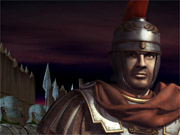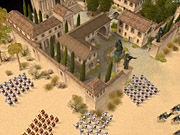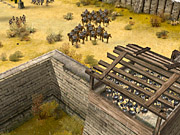Praetorians Updated Preview
We take a hands-on look at Pyro Studios' upcoming real-time strategy game set in ancient Rome.
We were fortunate enough to recently get a chance to play a nearly complete version of Praetorians, the upcoming real-time strategy game from Pyro Studios. The developer has made something of a name for itself with the Commandos tactical strategy games, which let you take control of a small squad of highly talented and highly specialized elite soldiers behind enemy lines during World War II. But from what we've seen, Praetorians will be considerably different from most real-time strategy games--which usually require you to quickly harvest resources, build up a base, and churn out an army to fight your enemy--and from the small-scale tactical strategy of Commandos 2. Instead of commanding a handful of soldiers, you'll command an actual army in the time of the ancient Roman Empire. Your troops will be divided into specific battalions, each with its own formations, individual abilities, and tactical strengths on the battlefield.

But as you might expect from the creator of Commandos, Praetorians will emphasize clever tactics over clumsy rushes. This is partially due to the fact that Praetorians will have only one resource: villagers who can be trained as soldiers to serve in your army once you've captured a town. There's no gold, food, wood, or any other resource to frantically harvest and dump into building extensive bases and hordes of units. Instead, you can recruit soldiers using your commanding officer unit, a powerful soldier who grants combat bonuses to any nearby allies. In most real-time strategy games, creating new units for your armies costs a certain amount of resources per unit. In Praetorians, you instead need to wait a certain amount of time for the training of your villagers to be completed--the more powerful the unit, the longer it will take longer to train, and in the meantime, your commanding officer will be sequestered in the village and will be unavailable to grant any sort of bonus to the rest of his troops. The game does feature some minimal base-building elements, but there aren't dedicated worker units, so you'll need to devote some troops to the task. The auxiliary infantry are the lowest-ranking troops in the game and can build garrisons, defense towers (which provide enhanced line of sight and a defense bonus for entrenched archers), and a few other structures.
The real battlefield tactics will come into play once you begin taking advantage of your units' special abilities and formations. Though nearly all units are combat-ready, most have one or more special abilities that range from hurling spears at enemies from a distance to gradually healing wounded soldiers over time. Each of your battalions has two meters to keep track of: health and stamina. Obviously, the lower your battalion's health, the closer it is to being destroyed, though having a healer unit on hand can help you save the lives of your individual troops. Stamina is used for both special abilities and forced marches, which you can order by double-clicking on your destination. The stamina meter will allow for some interesting tactical decisions. For example, if a town or friendly unit is under attack, players will have to decide whether they wish to rush reinforcements to the scene of the battle, or to conserve their armies' energy to use their battalions' powerful special abilities when they eventually arrive. Then again, most battalions can consist of up to 30 units, and they can be divided into much smaller groups that can be used as effective decoys and lures.

Furthermore, many units have one or more special formations in addition to simply standing ready. For instance, spearmen can stand their ground with pikes forward to meet oncoming cavalry charges, and Roman legionnaires can use the well-known turtle formation to cover their the front, sides, back, and top of their squad with heavy shields--a formation that grants considerable defensive bonuses but slows the soldiers' movement to a crawl. And all units can be given orders to and stop facing a specific direction. The direction your units are facing is important because even the most highly disciplined regiments can't turn on a dime, especially if they've been ambushed from the rear. Since you move your units in Praetorians by selecting them and right-clicking on the destination, you can alter the direction they're facing by right-clicking, holding the mouse button, and then dragging in whichever direction you want your battalions to face.

Environments will also play a considerable role in Praetorians' battles. As we've described in earlier previews, soldiers benefit from increased visibility and accuracy when they have the high ground, and lighter infantry groups can actually stage ambushes by hiding in dense forests, in which they're practically invisible until they're either encountered head-on or discovered by a scout. However, Praetorians will also feature impressive siege battles that take place in and around huge castles. The game has three different camera views that you can use to view your troops, and each is zoomed out fairly far away from the action, but when you see the castle sieges, you'll understand why. While victory in Praetorians generally seems to revolve around smart use of mixed forces, such as archers to attack from a distance, pikemen in the front to fend off charges, and healers and commanders carefully remaining just within range of both, laying siege to castles requires breaching the front gates with battering rams, smashing walls with catapults, and picking off defenders with ballistae and archers.
By all appearances, Praetorians is a distinctive and very promising real-time strategy game. The final game will have a sizeable single-player campaign consisting of 24 campaign missions, as well as about 16 skirmish maps for multiplayer, so it should offer prospective emperors enough in the way of epic battles to last them for quite some time. Praetorians is scheduled for release in February, but for now, be sure to
Got a news tip or want to contact us directly? Email news@gamespot.com
Join the conversation